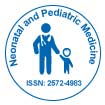Premature: Understanding Early Occurrences and Their Impacts
Received: 03-Feb-2025 / Manuscript No. nnp-25-171019 / Editor assigned: 06-Feb-2025 / PreQC No. nnp-25-171019 / Reviewed: 18-Feb-2025 / QC No. nnp-25-171019 / Revised: 22-Feb-2025 / Manuscript No. nnp-25-171019 / Published Date: 28-Feb-2025
Introduction
The term “premature” refers to something happening earlier than expected or before the proper time. It is commonly used in medical, developmental, and social contexts to describe events or conditions that occur ahead of the usual timeline. Prematurity can have significant consequences, ranging from minor inconveniences to serious health implications. In particular, premature birth—the birth of a baby before 37 weeks of gestation—is a global concern, affecting millions of families every year. Understanding the causes, implications, and preventive measures of premature events is crucial to mitigating risks and ensuring better outcomes [1],[2].
Discussion
Premature events manifest in various forms. In medicine, the most widely discussed is premature birth. Infants born prematurely often face health challenges such as underdeveloped organs, respiratory difficulties, and increased susceptibility to infections. The degree of prematurity plays a critical role in the severity of complications, with extremely preterm infants facing the highest risks. Advancements in neonatal care, however, have significantly improved survival rates and long-term outcomes for premature babies, though challenges remain [3],4].
Beyond medicine, prematurity can also affect psychological, social, and professional aspects of life. For instance, premature decisions in business or personal relationships—acting without sufficient information or reflection—can lead to undesirable consequences. The concept of “premature judgment” is widely recognized as a source of misunderstanding and conflict. Similarly, premature aging, whether due to lifestyle choices, stress, or genetic factors, can impact overall health and quality of life [5],6].
Causes of prematurity vary depending on the context. In the case of preterm births, factors include maternal health conditions such as hypertension or diabetes, infections, stress, multiple pregnancies, and lifestyle choices like smoking or poor nutrition [7],8]. In non-medical contexts, premature actions often result from impulsivity, pressure, or lack of experience. Awareness and education are essential tools in addressing prematurity across all these domains. Prenatal care, healthy lifestyle practices, informed decision-making, and mindfulness can significantly reduce the risks associated with premature occurrences [9],10].
Preventive measures play a vital role in minimizing the impact of prematurity. In neonatal care, regular check-ups, timely medical interventions, and maternal health monitoring are crucial. On the personal and professional fronts, developing patience, critical thinking, and strategic planning can help prevent premature decisions that might lead to negative outcomes. Society also benefits from public awareness campaigns that highlight the risks and implications of prematurity, fostering a more informed and proactive approach.
Conclusion
Premature events, whether medical, social, or psychological, can have lasting consequences if not properly managed. While premature birth poses immediate and long-term health challenges, other forms of prematurity, such as hasty decisions or premature aging, carry significant implications for personal and professional life. Understanding the causes, recognizing the risks, and implementing preventive measures are essential to mitigating the negative effects of prematurity. By fostering awareness, practicing caution, and promoting proactive care, individuals and communities can better navigate the challenges associated with events that occur before their proper time. Prematurity, while sometimes unavoidable, can be managed effectively with knowledge, preparedness, and mindful action.
References
- More K, Sakhuja P, Shah PS (2014) Minimally invasive surfactant administration in preterm infants: a meta-narrative review. JAMA Pediatr 168: 901–908.
- Herting E (2013) Less Invasive Surfactant Administration (LISA) - ways to deliver surfactant inspontaneously breathing infants. Early Hum Dev 89:875–880.
- Verder H, Agertoft L, Albertsen P (1992) Surfactant treatment of newborn infants with respiratory distress syndrome primarily treated with nasal continuous positive air pressure. A pilot study. Ugeskr Laeger 154:2136–2139.
- Verder H, Robertson B, Greisen G (1992) Surfactant therapy and nasal continuous positive airway pressure for newborns with respiratory distress syndrome. Danish-Swedish Multicenter Study Group. N Engl J Med 331:1051–1055.
- Dargaville PA, Gerber A, Johansson S (2016) Australian and New Zealand Neonatal Network. Incidence and outcome of CPAP failure in preterm infants. Pediatrics 138: 985.
- Kribs A, Pillekamp F, Hunseler C (2007) Early administration of surfactant in spontaneous breathing with nCPAP: feasibility and outcome in extremely premature infants (postmenstrual age 27 weeks). Paediatr Anaesth 17:364–369.
- Herting E, Hartel C, Gopel W (2019) Less invasive surfactant administration (LISA): chances and limitations. Arch Dis Child Fetal Neonatal Ed 104: F655–F659.
- Kribs A, Vierzig A, Hunseler C, Eifinger F, Welzing L, et al. (2008) Early surfactant in spontaneously breathing with nCPAP in ELBW infants: a single centre four-year experience. Acta Paediatr 97:293-298.
- Dargaville PA, Aiyappan A, Cornelius A, Williams C, De Paoli AG (2011) Preliminary evaluation of a new technique of minimally invasive surfactant therapy. Arch Dis Child Fetal Neonatal Ed 96: 243-248.
- Dargaville PA, Aiyappan A, Kuschel CA, Kamlin CO, De Paoli AG, et al. (2013) Minimally invasive therapy in preterm infants on continuous positive airway pressure. Arch Dis Child Fetal Neonatal Ed 98: 122-126.
Citation: Astha K (2025) Premature: Understanding Early Occurrences and Their Impacts. Neonat Pediatr Med 11: 504.
Copyright: © 2025 Astha K. This is an open-access article distributed under the terms of the Creative Commons Attribution License, which permits unrestricted use, distribution, and reproduction in any medium, provided the original author and source are credited.
Select your language of interest to view the total content in your interested language
Share This Article
Recommended Journals
Open Access Journals
Article Usage
- Total views: 239
- [From(publication date): 0-0 - Dec 09, 2025]
- Breakdown by view type
- HTML page views: 179
- PDF downloads: 60
